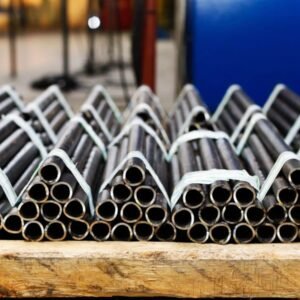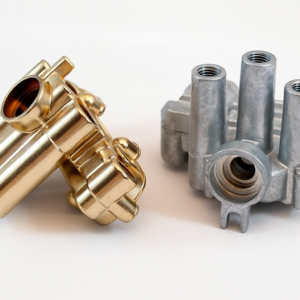In the precision world of CNC machining, materials present their own unique sets of opportunities and challenges. One material that exemplifies this perfectly is Teflon, more formally known as Polytetrafluoroethylene (PTFE). This article provides a thorough exploration of machining Teflon/PTFE, covering considerations, expert tips, best practices, and applications to ensure your projects achieve optimal results.
What is Teflon/PTFE Material?
Polytetrafluoroethylene (PTFE), commonly recognized by its trade name Teflon, is a high-performance synthetic fluoropolymer of tetrafluoroethylene known for its extraordinary combination of properties:
High heat resistance: Retains stability at continuous operating temperatures of up to 260°C (500°F).
Exceptionally low friction: Has one of the lowest coefficients of friction among solid materials, making it ideal for lubrication and non-stick applications.
Superior chemical inertness: Resists a vast array of aggressive chemicals, including acids, alkalis, solvents, and fuels.
Outstanding electrical insulation: Exceptional dielectric strength makes it invaluable in electronics.
Low weight and durability: Lightweight yet extremely durable, ideal for aerospace, automotive, and industrial use.
What Makes Teflon/PTFE Unique in CNC Machining?
Machining Teflon presents special considerations due to its distinctive physical properties:
Non-stick characteristic: While beneficial in final use, this trait complicates machining as PTFE tends to smear under cutting tools.
Poor thermal conductivity: Heat generated during machining remains localized, risking deformation and melting.
Softness and flexibility: Demands gentler cutting techniques and specialized tools.
High creep rate: Teflon gradually deforms under sustained pressure, necessitating careful dimensional allowances during design and machining.
Chemical inertness: Critical to maintain during machining, particularly in sealing and precision components.
Different Machining Processes for Teflon/PTFE
Several machining methods can achieve accurate and precise Teflon components:
CNC Milling
CNC milling provides precise and intricate part geometries. To effectively machine PTFE:
Utilize sharp single-point cutting tools (preferably carbide or HSS).
Employ carefully balanced cutting speeds (200-400 m/min) and feed rates (0.1-0.25 mm/rev) to prevent excessive heat and deformation.
CNC Turning
CNC turning is suitable for cylindrical and rotationally symmetric PTFE parts:
Select sharp, positive rake angle cutting tools.
Operate with moderate to slow speeds and faster feed rates to minimize heat buildup and material deformation.
Drilling and Tapping
Machining precise holes and threads in PTFE is challenging due to its softness:
Use drills with parabolic flute geometry and high helix angles.
Carefully control drill speeds (50-100 m/min) and peck-drill to aid chip removal.
Employ precision taps designed explicitly for softer materials to prevent oversize or torn threads.
Grinding and Finishing
Precision grinding achieves accurate dimensions and surface finishes:
Use diamond grinding wheels at moderate speeds.
Incorporate frequent cooling intervals to manage the heat generated.
Die Cutting and Waterjet Cutting
Alternative methods for sheets and plates:
Die cutting for thin sheets ensures quick production of precise shapes.
Waterjet cutting effectively cuts thicker PTFE sheets without heat distortion, using abrasive additives if necessary.
Essential Considerations and Expert Tips for Machining Teflon/PTFE
Based on extensive CNC machining experience, here are crucial practices for effectively working with Teflon/PTFE:
Tool Selection:
Sharp tools made from carbide or high-speed steel are essential to maintain cutting edge and minimize heat generation.
Control Heat Generation:
Utilize coolants, moderate speeds, and maintain sharpness to prevent overheating and deformation.
Proper Material Support:
Custom fixtures securely hold and evenly distribute machining stresses, preventing warping.
Minimizing Material Smearing:
Adopt slower speeds, sharp tooling, correct feed rates, and possibly freeze PTFE temporarily to enhance rigidity.
Design Adjustments for Creep:
Factor in material’s creep behavior, adjusting dimensional tolerances accordingly to ensure long-term performance.
Surface Finishing Techniques:
Employ fine-grit sanding, polishing, or chemical etching to achieve smooth, burr-free finishes.
Environmental Safety Measures:
Maintain proper ventilation and dust extraction systems to manage fine PTFE particles effectively.
Precision and Tolerance Management:
Conservative tolerance ranges (typically ±0.05 mm or tighter) are advised, with allowances for deformation and creep.
Deburring and Edge Finishing:
Apply gentle manual or chemical deburring methods to preserve part integrity and avoid deformation.
Preventing Heat and Pressure Deformation:
Allow parts to rest between roughing and finishing stages to relieve internal stresses, and carefully plan machining sequences.
Final Inspection and Quality Assurance:
Thorough dimensional inspections post-machining ensure strict adherence to specifications.
Why CNC Machining is Ideal for Teflon/PTFE
CNC machining is particularly suitable for PTFE due to:
Precision and Complexity: CNC offers high accuracy (±0.01 mm typical) and intricate part capabilities unmatched by manual methods.
Consistency and Repeatability: Ideal for consistent mass production, maintaining identical standards throughout the run.
Reduced Material Waste: Maximizes PTFE usage, minimizing cost per part through precision material removal.
Operational Flexibility: Capable of milling, turning, drilling, and complex 3D operations tailored to PTFE’s needs.
Controlled Machining Environment: CNC machining conditions are stable and consistent, ideal for sensitive PTFE machining.
Applications of Machined Teflon/PTFE Parts
Machined PTFE is highly versatile and widely applied across various sectors:
Aerospace: Bearings, seals, gaskets requiring heat resistance and low friction.
Medical Industry: Surgical tools, implants, chemically inert medical device components.
Electronics: High-performance electrical insulators, connectors.
Chemical Processing: Corrosion-resistant pumps, valves, piping.
Automotive: Under-hood seals, insulators, high-temperature resistant components.
Food Industry: Food-safe, non-stick processing equipment.
Semiconductor Manufacturing: Wafer carriers, chemical-resistant insulating components.
Disadvantages of Machining Teflon/PTFE
While beneficial, PTFE machining has inherent drawbacks:
Limited to operational temperatures below 260°C.
Creep-induced deformation, challenging for long-term load-bearing applications.
Lower mechanical strength compared to alternatives (PEEK, Nylon).
Difficulty in bonding requires specialized adhesives and surface treatments.
Higher machining costs due to specialized techniques.
Environmental concerns regarding PTFE production chemicals.
Machining complexity requires expert-level handling.
Alternative Materials to Teflon/PTFE
When Teflon/PTFE is unsuitable, the following alternative engineering plastics are viable:
PEEK: Superior mechanical strength, thermal stability, and wear resistance.
Nylon: Cost-effective alternative with reasonable mechanical strength and wear resistance.
Polypropylene: Good chemical resistance at moderate temperatures.
PVDF: Fluoropolymer with good chemical resistance and better dimensional stability than PP.
UHMW: Excellent impact strength and abrasion resistance for wear-intensive applications.
PCTFE: Chemical resistance with better dimensional stability and lower creep rate than PTFE.
Conclusion
Successfully machining Teflon/PTFE demands a profound understanding of its unique properties, strategic planning, precise tooling, and sophisticated machining approaches. By adhering to the considerations and tips provided, manufacturers can unlock PTFE’s tremendous potential across diverse industrial applications.
At Tops Precision, our CNC machining expertise and dedicated support ensure you benefit from high-quality, precision-machined Teflon components tailored to your exact requirements.




